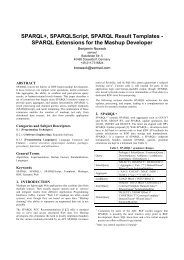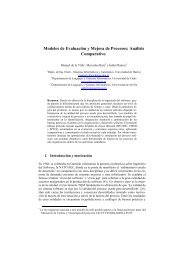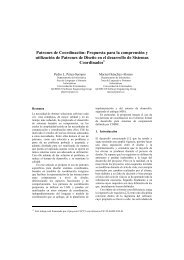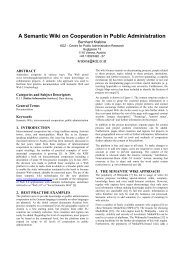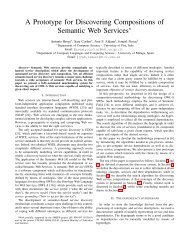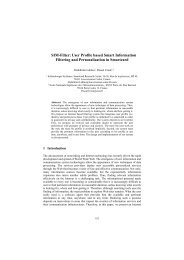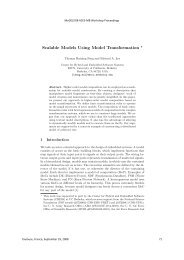ontology-based information extraction systems (obies 2008)
ontology-based information extraction systems (obies 2008)
ontology-based information extraction systems (obies 2008)
You also want an ePaper? Increase the reach of your titles
YUMPU automatically turns print PDFs into web optimized ePapers that Google loves.
Connexor 5 FDG parser) and feeds wording and parser output into the agents’<br />
production line by putting it onto the TextBlackBoard. He calls Frieda.<br />
Let us assume for the sake of a demo that Kurt comes up with the sentence<br />
“All patients at cmv risk were administered high-dose ganciclovir.“<br />
It will be hit by 9 <strong>ontology</strong> propositions (see table 2). We follow proposition 17685.<br />
Candidate propositions in a parsed sentence. Frieda picks up the new input.<br />
She finds candidate propositions in a parsed sentence and annotates them (see table 3,<br />
columns 8 – 13). She distinguishes verbal, prepositional and attributive candidate<br />
propositions. As soon as her annotation is done, Frieda activates the agent Heini.<br />
Table 3. An example dependency parser output with 3 annotated propositions of different<br />
types. Columns 1 - 7 display the parse, columns 8 – 13 the proposition candidates.<br />
1 2 3 4 5 6 7 8 9 10 11 12 13<br />
1 all DET @DN> %>N det: *<br />
2 patient N NOM PL @SUBJ %NH subj: arg1 modhead2<br />
3 at PREP @ %>N attr: arg1 modarg 2 attr 3<br />
5 risk N NOM SG @ %>N attr: arg1<br />
9 ganciclovir N NOM SG @OBJ %NH obj: arg1<br />
Sending propositions to interpretation. Heini is the proposition dispatcher. He<br />
selects the propositions one by one from the current sentence and initiates their<br />
verification. As long as he has input, he submits it to Hugo. When all propositions of<br />
the current sentence are done, he calls Paula, the tidy-up agent.<br />
Fig. 2. An <strong>ontology</strong> proposition equipped with a unifier for all drugs.<br />
Finding <strong>ontology</strong> propositions. Hugo checks whether the current proposition shares<br />
at least two <strong>ontology</strong> concepts with any of the <strong>ontology</strong> propositions. As soon as he is<br />
done with a concept pair and has some results, Hugo passes the text-<strong>based</strong> proposition<br />
with the IDs of selected <strong>ontology</strong> propositions - and possibly some add-ons due to<br />
unifiers - to the TextBlackbord. He activates Rudi. If Hugo cannot find matching<br />
<strong>ontology</strong> propositions, he returns to Heini and asks for new supplies.<br />
When Hugo begins to treat a new proposition, he puts the IDs of occurring <strong>ontology</strong><br />
5 http://www.connexor.com/



